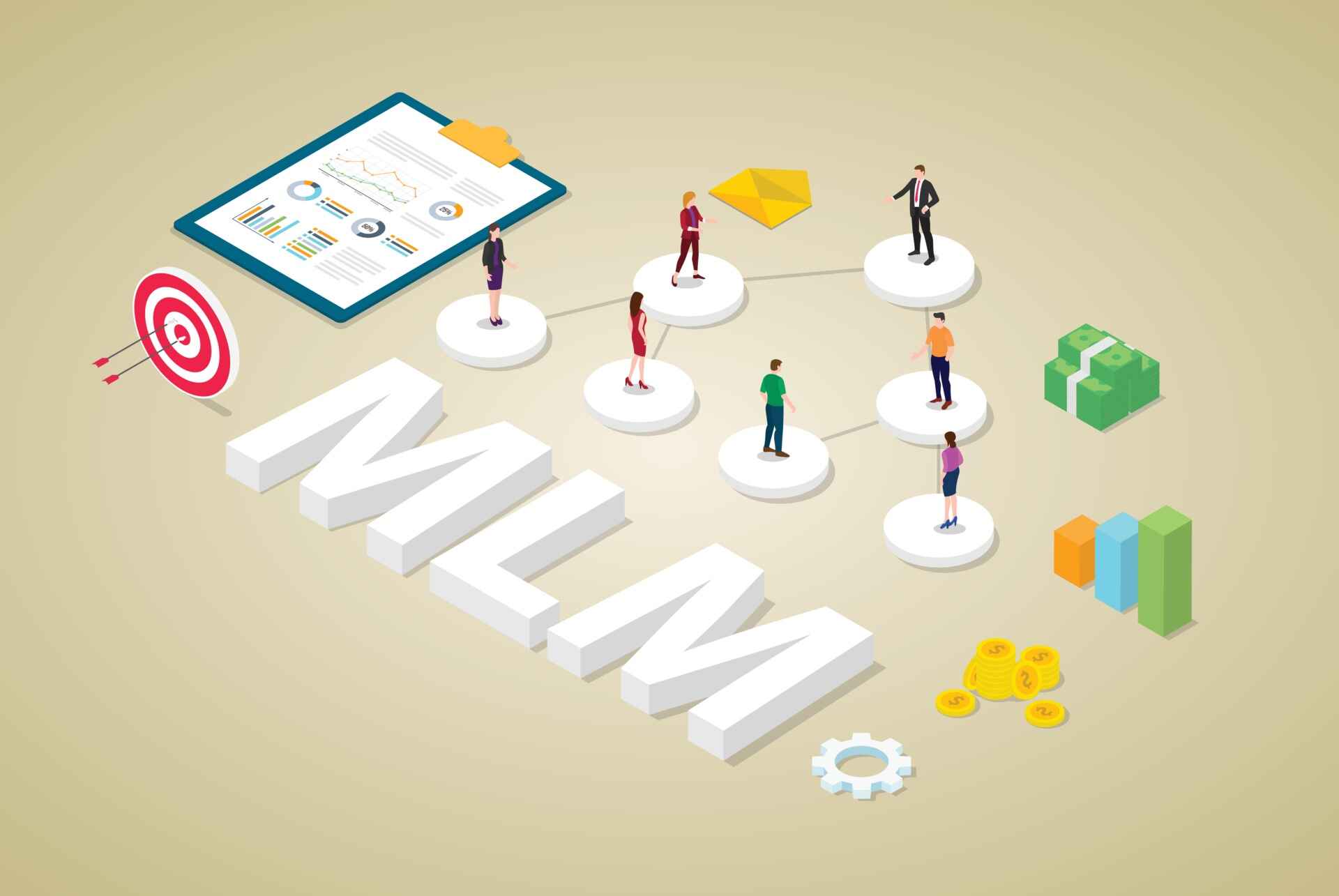Building a custom MLM system software can be the game-changer your business needs, whether you’re starting fresh or growing your network. With the right tools, you can streamline workflows, manage commissions, and empower your team for success.
In this guide, you’ll discover everything you need to know about MLM system software, from essential features to budgeting tips. We’ll walk you through the development process, ensuring compliance, security, and ongoing support, so you can focus on growing your MLM business.
1. Understanding MLM Business Models

Before developing an MLM system software, you need to understand the various MLM business models. Let’s break down some of the most common ones.
Binary MLM Model
This is one of the most popular models, where each member recruits two new members. The structure grows in a binary tree, which is easy to understand and manage. The system balances the two legs automatically to ensure fair commissions, making it simple for your team to build their network.
Unilevel MLM Model
The Unilevel MLM model allows members to recruit as many people as they want on their first level. There’s no balancing required, and commission payouts are made based on personal sales and the team’s overall performance. It’s a simple method, perfect for businesses wanting simplicity in their MLM business.
Matrix MLM Model
In this model, the number of recruits in each level is fixed, often in a 3×3, 4×7, or 5×7 structure. When a level is full, any new recruits spill over to the next level. This model encourages teamwork and ensures members aren’t left behind, as excess recruits benefit everyone.
Hybrid MLM Model
The hybrid model combines features from various MLM models to suit your business needs. For instance, you could merge the Binary and Unilevel structures. This flexibility allows your MLM system to offer a unique compensation plan that keeps members motivated.
Generation MLM Model
The Generation model focuses on long-term relationships, rewarding members not only for recruiting but also for building strong sales teams. Commissions are earned over generations, ensuring that top performers are continuously compensated for growing their network.
2. Essential Features for MLM System Software

To build an effective MLM system software, there are key features that you should consider. These elements make the system efficient and user-friendly.
Automated Commission Tracking
One of the most crucial features in an MLM system software is automated commission tracking. You’ll want your software to calculate commissions accurately, ensuring fair payouts. Automation minimises manual errors and boosts trust within your network.
User-Friendly Dashboard
A well-designed, easy-to-navigate dashboard is a must for any MLM system software. It should provide members with live updates on their performance, commissions, and downline growth. The dashboard should be accessible both on desktop and mobile, so users can manage their business on the go.
Customer Relationship Management (CRM)
An integrated CRM helps members manage their prospects and customers. This tool should include features like lead tracking, follow-up reminders, and email templates. With CRM integration, your MLM system software becomes more than just a sales platform; it’s a full-fledged business management tool.
E-Wallet and Payment Gateways
An e-wallet feature allows users to save and withdraw their earnings conveniently. Seamless integration with popular payment gateways ensures that your members receive their commissions quickly, regardless of where they are located.
Replicated Websites for Members
Providing each member with their own replicated website can help them market and grow their business independently. The replicated site should include product details, a simple signup process, and personalised branding. This feature amplifies the marketing efforts of your entire network.
3. Choosing the Right Development Partner

Selecting the right development partner for your MLM system software can make or break your project. Here’s what you need to look for.
Experience in MLM Systems
Not all developers are familiar with the complexities of MLM systems. Choose a partner with proven experience in MLM system software development like Zoomo Tech. They should understand the intricacies of various MLM models and be able to design a system that suits your needs.
Customisation Capabilities
Every MLM business is unique. You’ll want a development partner who can offer high levels of customisation, from the compensation plan to the user interface. Customisation ensures that your MLM system software reflects your brand’s identity and serves your specific business goals.
Strong Technical Expertise
Your development partner must have strong technical expertise in website development and mobile app development. Look for a team that is skilled in the latest technologies, such as cloud computing, blockchain, and mobile responsiveness. This ensures your MLM system is future-proof and scalable.
Effective Communication
A successful project relies on open and transparent communication. Choose a partner who provides frequent updates, listens to your requirements, and offers valuable input. Clear communication will save you time and prevent costly misunderstandings during the development process.
Post-Development Support
Even after your MLM system software is launched, your development partner should offer post-development support. This includes fixing bugs, upgrading features, and providing general maintenance. Long-term support guarantees that your MLM platform remains robust and efficient.
4. Customisation Options for Your MLM Business Needs

Your MLM system software should offer a range of customisation options to meet your specific business needs. Here’s what you should consider.
Customisable Compensation Plans
No two MLM businesses have the same compensation plan. Your MLM system should allow for customisable commission structures, ensuring that your plan motivates your team effectively. From binary to unilevel, you should have the flexibility to adapt the system to your strategy.
Tailored Reporting Tools
Custom reporting tools allow you to generate reports that suit your business model. Whether you need performance metrics, commission breakdowns, or compliance reports, the system should offer flexibility in generating custom data analytics.
Branding for Your Business
Your MLM system software should reflect your company’s branding. Customisation options for your platform’s design, colour scheme, and logo placement are important for creating a cohesive brand experience across your network. This branding reinforces your business identity and makes it recognisable.
Multi-Language and Multi-Currency Support
If your MLM operates in multiple regions, it’s essential to offer multi-language and multi-currency support. Your software should allow customisation to cater to different languages and currencies, ensuring seamless operation no matter where your team is located.
5. The Importance of Security in MLM Platforms

Security is a critical component when developing an MLM system software. Your platform will handle sensitive data, making it essential to prioritise robust security measures.
Data Encryption
To protect user information, your MLM system software should use advanced data encryption techniques. Encryption ensures that even if data is intercepted, it cannot be read or tampered with. This helps to secure sensitive details like payment information, personal information, and commission payouts.
Two-Factor Authentication (2FA)
Two-factor authentication is a must-have feature to enhance account security. By requiring an additional verification step, like a one-time password (OTP) sent via SMS or email, you reduce the risk of unauthorised access to member accounts.
Role-Based Access Control (RBAC)
Not everyone in your organisation needs full access to all features of your MLM software. Implementing role-based access control (or access rights control) allows you to assign specific roles and permissions based on user responsibilities. This limits the risk of accidental or malicious data exposure.
Secure Payment Gateways
Your MLM systems handling commissions and payouts, integrating secure payment gateways is vital. You should choose a payment gateway carefully, ensure that the payment process is encrypted and complies with global security standards, such as PCI-DSS, to protect your members’ financial data. Still unsure which Payment Gateway to choose? Contact Zoomo Tech for more advice on selecting the right one.
6. How to Ensure Compliance with MLM Regulations

Compliance with local and international regulations is crucial for the long-term success of your MLM business. Here’s how you can ensure your platform meets legal standards.
Adhering to Local MLM Laws
Different countries have different laws governing MLM operations. It’s essential to understand the legal obligations in the countries where you operate. Your MLM system should have features that help you comply with local regulations, such as ensuring proper disclosures and managing commissions transparently.
Anti-Pyramid Scheme Regulations
MLM businesses must differentiate themselves from illegal pyramid schemes. Your MLM system should clearly follow legitimate business practices, including transparent product sales and ensuring that compensation is based on sales, not recruitment. This helps avoid legal pitfalls and builds trust with your network.
Compliance Reporting Tools
To stay compliant, your MLM system should have built-in reporting tools. These tools can generate compliance reports, track sales performance, and ensure that all payouts are in line with legal standards. Having easy access to these reports simplifies the process of staying compliant with regulatory bodies.
PDPA and Data Privacy
If your MLM business operates in Malaysia and Singapore, you need to comply with data protection laws like the Personal Data Protection Act (PDPA). This includes obtaining proper consent from members for data usage and ensuring that their personal information is stored safely. Your MLM system software should support these privacy features to avoid hefty fines.
Legal Disclosures and Terms
Your MLM platform should include customisable legal disclosure templates and terms of service agreements. These should be displayed prominently during member signups, ensuring that everyone is aware of their rights and obligations. This transparency strengthens your business’s credibility and trustworthiness.
7. Budgeting for Custom MLM System Software Development

Developing a custom MLM system software requires careful budgeting to ensure you get the best value. Let’s explore the key factors that influence costs.
Development Scope
The scope of your system development is the biggest factor in determining cost. Are you building a simple platform with basic features, or do you need a fully customised solution with complex integrations? Define your scope early on to avoid budget excesses.
Custom Features
The more custom features you need, the higher the cost. Features like real-time reporting, multi-language support, and personalised dashboards can significantly increase the budget. However, these features also add value to your business, so it’s worth investing in quality.
Developer Expertise and Location
Developer rates vary depending on their expertise and location. Hiring a local development team may cost slightly more, but they might better understand your specific business environment, languages, and legal requirements. Alternatively, outsourcing to an overseas team can be a more cost-efficient option, but it’s essential to ensure they have experience in developing MLM system software and are familiar with all the necessary compliance requirements in Malaysia.
Ongoing Maintenance Costs
Your initial development costs aren’t the end of the story. You’ll need to budget for ongoing maintenance, including software updates, security patches, and customer support. Planning for these expenses in advance helps avoid surprises down the road.
Third-Party Integrations
If your MLM system software needs to integrate with third-party tools—such as payment gateways, CRM systems, or email marketing platforms—factor in the cost of those integrations. Some tools may require monthly fees or custom development work to integrate smoothly with your system. Still confuse about this? Contact Zoomo Tech to find out more.
8. Post-Launch Support and Updates for MLM System Software

Even after your MLM system software is live, post-launch support is essential to ensure smooth operations. Here’s what you should plan for.
Bug Fixes and Patches
No software is perfect at launch. Be prepared to handle bug fixes and patches as issues arise. A dedicated support team ensures that any technical problems are promptly resolved, keeping your system running efficiently for staffs and members.
Feature Updates
As your business grows, your MLM system software should evolve too. Post-launch support should include adding new features to keep your platform up to date with industry trends and member needs. This ensures that your software remains competitive and scalable.
System Performance Monitoring
Performance monitoring is crucial to identify potential bottlenecks or downtime. Your maintenance support team should regularly monitor the system’s performance, ensuring that it can handle increasing traffic and data loads as your network expands.
User Training and Documentation
Your members need to know how to use the system effectively. Post-launch support should include training materials, tutorials, and FAQs to help users effectively use the platform. This reduces the burden on your support team and empowers members to use the system independently.
Long-Term Support Contracts
Consider establishing a long-term support contract with your developer partner to ensure consistent updates and maintenance. This guarantees that your system remains secure, compliant, and optimised for years to come, protecting your investment.
Conclusion
In summary, developing a custom MLM system software involves understanding MLM models, incorporating essential features, and ensuring security and compliance. Budgeting wisely, choosing the right development partner, and planning for ongoing support are all key to creating a successful platform that meets your business needs and grows with your network.
At Zoomo Tech, we specialise in building tailored MLM system software for businesses like yours. Whether you need a secure, scalable platform or post-launch support, we’re here to guide you every step of the way. Let us help you create a system that empowers your business to thrive.




